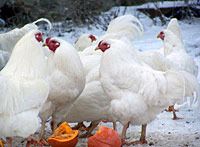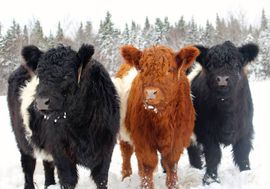Chicken
One of the great difficulties in getting a handle on poultry numbers: people do not seem to keep chickens very long. RBC is presently undertaking a Ridley Bronze turkey survey and a Chantecler chicken survey. The information collected should give us a better understanding of the population sizes and distribution.
The American Livestock Breeds Conservancy (ALBC) has asked our help with a chicken census. To my knowledge this is the first time that ALBC has decided to extend their interest to all breeds of poultry in North America. It is a difficult task and one that Dan Price-Jones, poultry coordinator emeritus, and I tried on a small scale, at one time, with one or two breeds, for the United Nations Food and Agriculture Organization (FAO) in Rome.
It is essential that RBC poultry breeders register themselves on the RBC website, so that at least we know what resources exist within our own organization. Contact the RBC office and add your name to the poultry breeders list.
The demand for Canada’s only native breed of chicken, the Chantecler has skyrocketed. We need more breeders in all parts of the country.
The American Livestock Breeds Conservancy (ALBC) has asked our help with a chicken census. To my knowledge this is the first time that ALBC has decided to extend their interest to all breeds of poultry in North America. It is a difficult task and one that Dan Price-Jones, poultry coordinator emeritus, and I tried on a small scale, at one time, with one or two breeds, for the United Nations Food and Agriculture Organization (FAO) in Rome.
It is essential that RBC poultry breeders register themselves on the RBC website, so that at least we know what resources exist within our own organization. Contact the RBC office and add your name to the poultry breeders list.
The demand for Canada’s only native breed of chicken, the Chantecler has skyrocketed. We need more breeders in all parts of the country.
| CRITICAL [< 100] | ENDANGERED [100-499] | VULNERABLE [500-999] | AT RISK [1000+] |
|---|---|---|---|
| Ancona | Chantecler | Black Jersey Giant | Barred Plymouth Rock |
| Houdan | Shaver White Leghorn (2 strains) | Minorca | |
| Silver Grey Dorking | Columbian Rock | New Hampshire Red | |
| White Wyandotte | Hungarian Yellow | Rhode Island Red | |
| Brown Leghorn | Light Sussex | ||
| Munro Leghorn | |||
| White Jersey Giant | |||
| Saskatchewan Plymouth Barred Rock |




Turkeys
Heritage or Standard turkeys are similar to the ones that were raised early last century, before the broad-breasted kind had been developed. They have long productive lives, can mate naturally and do well under outdoor management. They are hardy, slow growing and proven to have superior immunity compared to the present-day commercial birds. They reach slaughter weight at about 30 weeks but will have better carcass quality after another month or two of growth. www.albc-usa.org/cpl/turkdefinition.htm
The only variety that has more than 1000 breeding females is the Bronze turkey. Several strains exist, such as the Ridley Bronze, the Rochester Hatchery flock in Westlock, AB and the Beaton family flock in Black Creek, BC. The Wishard strain from Oregon was popular on the west coast but has not been kept pure.
Bourbon Reds and Blacks may have only just over 100 breeding females. Black-feathered turkeys may be of the Black Spanish variety or could be of Blue Slate origin. (When Blue Slates breed they produce about one quarter black offspring, which breed true and are indistinguishable from Black Spanish. Whether they are separate varieties is unclear. The study of turkey feather DNA by Dr. Yves Plante of the Canadian Farm Animal Genetic Resources Foundation may answer this question.)
Other varieties known to have been traditionally raised in Canada are the Narragansett, Blue Slate, Beltsville and White Holland. The first three probably have less than 100 breeding females now; to my knowledge there are no White Hollands left.
Other rare varieties exist in Canada but are not known to have ever been raised commercially. These include Jersey Buff, Chocolate and Midget White, many of which appear on the show circuit and are recent imports. Royal Palms have been here for longer but, although just as edible as all other turkeys, their small size and slow growth makes them less suitable for meat production.
With the exception of the three Bronze growers mentioned, nearly all the turkeys I hear about are raised for showing. This means that the numbers grown tend to be small, and only the outward and visible characteristics such as conformation and feather colour are assessed. Egg quality and quantity and mothering ability cannot be measured in such circumstances. If turkeys are to retain their former production characteristics they must be raised in larger numbers so that some meaningful selection can occur for the traits that make a farm flock successful and profitable.
More breeders and better methods of sharing genetics are desperately needed. When shipping poults by air or by mail, Murphy’s Law often comes into play but, with careful planning and very detailed instructions to the shipper, it is possible to get amazingly good results. I was ecstatic to hear that 13 Blue Slate poults have survived out of 18 eggs mailed from Salt Spring Island to Kamloops, BC and amazed to find that 44 out of 46 eggs from Alliston, Ont., which is a 3-day journey away, appear to be developing normally. If heritage turkeys are to be brought back from the brink of extinction and made available to all who wish to grow them for whatever reason, we have to use every available strategy to inform the public of their existence, their virtues and their availability.
A Ridley Bronze census will soon be underway with a view to learning more about breeders and populations. Please contact the Species Coordinator for more information. Margaret Thomson.
The only variety that has more than 1000 breeding females is the Bronze turkey. Several strains exist, such as the Ridley Bronze, the Rochester Hatchery flock in Westlock, AB and the Beaton family flock in Black Creek, BC. The Wishard strain from Oregon was popular on the west coast but has not been kept pure.
Bourbon Reds and Blacks may have only just over 100 breeding females. Black-feathered turkeys may be of the Black Spanish variety or could be of Blue Slate origin. (When Blue Slates breed they produce about one quarter black offspring, which breed true and are indistinguishable from Black Spanish. Whether they are separate varieties is unclear. The study of turkey feather DNA by Dr. Yves Plante of the Canadian Farm Animal Genetic Resources Foundation may answer this question.)
Other varieties known to have been traditionally raised in Canada are the Narragansett, Blue Slate, Beltsville and White Holland. The first three probably have less than 100 breeding females now; to my knowledge there are no White Hollands left.
Other rare varieties exist in Canada but are not known to have ever been raised commercially. These include Jersey Buff, Chocolate and Midget White, many of which appear on the show circuit and are recent imports. Royal Palms have been here for longer but, although just as edible as all other turkeys, their small size and slow growth makes them less suitable for meat production.
With the exception of the three Bronze growers mentioned, nearly all the turkeys I hear about are raised for showing. This means that the numbers grown tend to be small, and only the outward and visible characteristics such as conformation and feather colour are assessed. Egg quality and quantity and mothering ability cannot be measured in such circumstances. If turkeys are to retain their former production characteristics they must be raised in larger numbers so that some meaningful selection can occur for the traits that make a farm flock successful and profitable.
More breeders and better methods of sharing genetics are desperately needed. When shipping poults by air or by mail, Murphy’s Law often comes into play but, with careful planning and very detailed instructions to the shipper, it is possible to get amazingly good results. I was ecstatic to hear that 13 Blue Slate poults have survived out of 18 eggs mailed from Salt Spring Island to Kamloops, BC and amazed to find that 44 out of 46 eggs from Alliston, Ont., which is a 3-day journey away, appear to be developing normally. If heritage turkeys are to be brought back from the brink of extinction and made available to all who wish to grow them for whatever reason, we have to use every available strategy to inform the public of their existence, their virtues and their availability.
A Ridley Bronze census will soon be underway with a view to learning more about breeders and populations. Please contact the Species Coordinator for more information. Margaret Thomson.
| CRITICAL [< 100] |
ENDANGERED [100-499] |
VULNERABLE [500-999] |
AT RISK [1000+] |
|---|---|---|---|
| Beltsville Small White | Broad Breasted Bronze (Naturally Mating) |
Bourbon Red | [1000+] Norfolk Black |
| Ridley Bronze | Narragansett | Spanish | |
| Standard Bronze |







